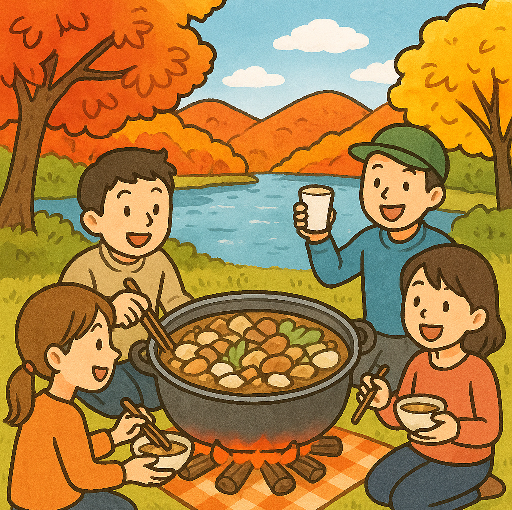
Autumn in northern Japan brings not only colorful leaves and cool breezes, but one of the most heartwarming cultural traditions you may ever encounter: imoni-kai (芋煮会). In Yamagata Prefecture especially, imoni-kai is not just a meal—it is a ritual of community, nature, and comfort.
What is Imoni
“Imoni” (literally “boiled potato/taro”) is a hearty stew traditionally made with satoimo (Japanese taro), meat (often beef or pork), konnyaku, green onions, and sometimes mushrooms or other local vegetables. What gives it its character are the regional variations in seasoning:
Imoni is usually cooked outdoors, often beside rivers, in autumn when taro is harvested. Friends, families, coworkers gather at imoni parties around a big pot over a fire, sharing not just food but stories, laughter, and a sense of the changing season.
History
The origins of imoni go back several centuries. According to historical sources, imoni emerged around the mid-1600s in areas of Yamagata such as Nakayama-machi, linked to river transport: boat operators would wait for arriving shipments and pass the time with communal cooking on riverbanks. Taro was often available locally, and dried fish or cod were used originally before beef became more common (especially from the early Showa period).
Over time, imoni became more than a practical way to cook; it became a seasonal staple and a social event. Schools, workplaces, neighborhoods hold imoni-kai regularly in September and October. For many in Tōhoku (the northeastern region of Japan), it’s a symbol of autumn itself.
The Imoni Festival in Yamagata: Scale & Popularity
While imoni-kai happens all over Tōhoku in smaller groups, Yamagata City hosts one of the largest imoni festivals in all Japan. Every September, the “Japan’s No. 1 Imoni Festival” (日本一の芋煮会フェスティバル) takes place by the Mamigasaki Riverbed.
This festival draws visitors not just from around Yamagata, but from all over Japan, and even from abroad. It is both a food event and a cultural spectacle.
Cultural Significance
Why does imoni-kai matter so much?
- It connects people with the land and the harvest, celebrating local produce (like taro) at the moment it is freshest.
- It strengthens community ties—preparing, cooking, eating together is a bonding experience.
- It marks the change of seasons—autumn is fleeting, and imoni-kai helps people slow down, enjoy the outdoors and the changing scenery.
- For visitors, imoni-kai offers an immersive way to taste local flavor (literally) and experience everyday Japanese culture outside the usual tour-paths.
If you want to plan a visit, you can check more details (dates, access, photos, etc.) on the official festival site: 日本一の芋煮会フェスティバル / Best Imoni Festival 日本一の芋煮会フェスティバル
芋煮会:山形の秋のシチューフェスティバルと日本の河原集まりの伝統
日本の北部の秋は、色とりどりの紅葉と涼しい風だけでなく、あなたが出会うかもしれない最も心温まる文化的伝統のひとつをもたらします:芋煮会(いもにかい)。特に山形県では、芋煮会は単なる食事ではなく、共同体、自然、そして安らぎの儀式です。
芋煮とは
「芋煮」(文字通り「芋を煮たもの」)は、伝統的には里芋、肉(牛肉または豚肉)、こんにゃく、ネギ、時にはキノコやその他の地元野菜を入れたボリュームたっぷりのシチューです。特徴を与えているのは地域ごとの味付けの違いです:
- 山形内陸では、スープは醤油ベースで牛肉を使う傾向があります。
- 庄内地方(日本海側)では、豚肉と味噌を調味料として使うことが多いです。
芋煮は通常、屋外で、しばしば川のほとりで、里芋が収穫される秋に作られます。友人や家族、同僚が大きな鍋を火にかけ、物語や笑い声、季節の移ろいを分かち合いながら芋煮会をします。
歴史
芋煮の起源は数世紀前にさかのぼります。歴史的資料によると、芋煮は1600年代半ば頃、山形の中山町などの地域で、川の交通と結びついて生まれました。船頭たちは荷物が届くのを待つ間、川原で一緒に料理をして時間を過ごしていました。里芋は地元でよく手に入り、もともとは干物やタラが使われていましたが、牛肉は(特に昭和初期から)より一般的になりました。
時が経つにつれ、芋煮は実用的な調理法以上のものとなり、季節の定番、社会的なイベントとなりました。学校や職場、地域社会では毎年9月から10月にかけて定期的に芋煮会が行われます。東北地方の多くの人々にとって、これは秋そのものの象徴です。
山形の芋煮フェスティバル:規模と人気
芋煮会は東北中で小規模なグループによって行われますが、山形市では日本最大級の芋煮フェスティバルが開催されます。毎年9月、「日本一の芋煮会フェスティバル」が馬見ヶ崎川の河川敷で行われます。
印象的な詳細は次の通りです:
- 巨大な鍋で約3万食が作られます。
- 使用される巨大鍋(「鍋太郎」と呼ばれる)は直径6.5メートルにもなります。
- かき混ぜるのに建設機械(バックホー)さえも使われます。
このフェスティバルは山形周辺だけでなく、日本中、さらには海外からも来訪者を引き寄せます。これは食のイベントであり、文化的な見どころでもあります。
文化的意義
なぜ芋煮会はそんなに大切なのでしょうか?
- 人々を土地と収穫に結びつけ、地元産の作物(里芋など)が最も新鮮な瞬間を祝います。
- 共同作業で絆を深める—準備、調理、食事を一緒に行うことは絆を深める体験です。
- 季節の移ろいを感じさせます—秋はあっという間に過ぎ去るため、芋煮会は人々が外でゆっくり過ごし、景色の変化を楽しむきっかけになります。
- 訪問者にとって、芋煮会は地元の味(文字通り)と日常的な日本文化を体験する没入的な方法を提供します。
訪問を計画したい場合は、日程、アクセス、写真などの詳細は公式フェスティバルサイトで確認できます:
日本一の芋煮会フェスティバル / Best Imoni Festival
